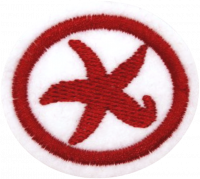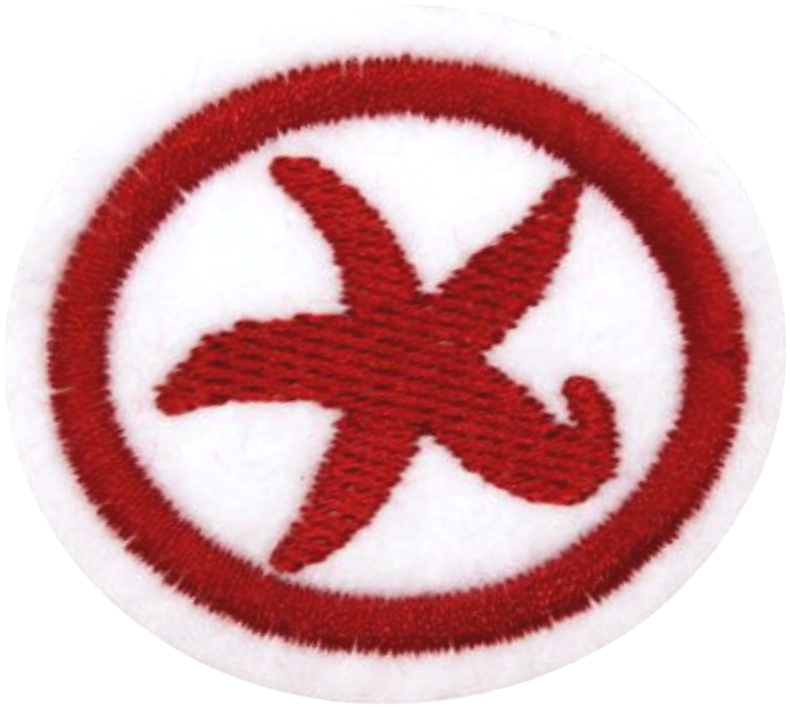Difference between revisions of "AY Honors/Echinoderms/Answer Key"
From Pathfinder Wiki
< AY Honors | EchinodermsAY Honors/Echinoderms/Answer Key
(+ Echinoderms SAD honor requirements) |
m (- Category of AYHAB) |
||
| (5 intermediate revisions by 2 users not shown) | |||
| Line 1: | Line 1: | ||
| − | + | {{HonorSubpage}} | |
| − | < | + | <section begin="Body" /> |
| − | {{ | + | {{ansreq|page={{#titleparts:{{PAGENAME}}|2|1}}|num=1}} |
| − | | | + | <noinclude><translate><!--T:28--> |
| − | | | + | </noinclude> |
| − | + | <!-- 1. In what environment can echinoderms be found? --> | |
| − | | | ||
| − | | | ||
| − | |||
| − | |||
| − | |||
| − | == | + | <!--T:29--> |
| + | <noinclude></translate></noinclude> | ||
| + | {{CloseReq}} <!-- 1 --> | ||
| + | {{ansreq|page={{#titleparts:{{PAGENAME}}|2|1}}|num=2}} | ||
| + | <noinclude><translate><!--T:30--> | ||
| + | </noinclude> | ||
| + | <!-- 2. What does the word Echinodermata mean, the name that characterizes the echinoderms? --> | ||
| − | == | + | <!--T:31--> |
| + | <noinclude></translate></noinclude> | ||
| + | {{CloseReq}} <!-- 2 --> | ||
| + | {{ansreq|page={{#titleparts:{{PAGENAME}}|2|1}}|num=3}} | ||
| + | <noinclude><translate><!--T:32--> | ||
| + | </noinclude> | ||
| + | <!-- 3. Name four characteristics of the phylum Echinodermata. --> | ||
| − | == | + | <!--T:33--> |
| + | <noinclude></translate></noinclude> | ||
| + | {{CloseReq}} <!-- 3 --> | ||
| + | {{ansreq|page={{#titleparts:{{PAGENAME}}|2|1}}|num=4}} | ||
| + | <noinclude><translate><!--T:34--> | ||
| + | </noinclude> | ||
| + | <!-- 4. What kind of symmetry do the echinoderms have? What does this mean? --> | ||
| − | == | + | <!--T:35--> |
| + | <noinclude></translate></noinclude> | ||
| + | {{CloseReq}} <!-- 4 --> | ||
| + | {{ansreq|page={{#titleparts:{{PAGENAME}}|2|1}}|num=5}} | ||
| + | <noinclude><translate><!--T:36--> | ||
| + | </noinclude> | ||
| + | <!-- 5. Name the main characteristics and give five examples of the classes of echinoderms: --> | ||
| − | == | + | <!--T:37--> |
| + | <noinclude></translate></noinclude> | ||
| + | {{ansreq|page={{#titleparts:{{PAGENAME}}|2|1}}|num=5a}} <!--T:7--> | ||
| + | <noinclude><translate><!--T:38--> | ||
| + | </noinclude> | ||
| − | == | + | <!--T:39--> |
| + | <noinclude></translate></noinclude> | ||
| + | {{CloseReq}} <!-- 5a --> | ||
| + | {{ansreq|page={{#titleparts:{{PAGENAME}}|2|1}}|num=5b}} <!--T:8--> | ||
| + | <noinclude><translate><!--T:40--> | ||
| + | </noinclude> | ||
| − | == | + | <!--T:41--> |
| + | <noinclude></translate></noinclude> | ||
| + | {{CloseReq}} <!-- 5b --> | ||
| + | {{ansreq|page={{#titleparts:{{PAGENAME}}|2|1}}|num=5c}} <!--T:9--> | ||
| + | <noinclude><translate><!--T:42--> | ||
| + | </noinclude> | ||
| − | == | + | <!--T:43--> |
| + | <noinclude></translate></noinclude> | ||
| + | {{CloseReq}} <!-- 5c --> | ||
| + | {{ansreq|page={{#titleparts:{{PAGENAME}}|2|1}}|num=5d}} <!--T:10--> | ||
| + | <noinclude><translate><!--T:44--> | ||
| + | </noinclude> | ||
| − | == | + | <!--T:45--> |
| + | <noinclude></translate></noinclude> | ||
| + | {{CloseReq}} <!-- 5d --> | ||
| + | {{ansreq|page={{#titleparts:{{PAGENAME}}|2|1}}|num=5e}} <!--T:11--> | ||
| + | <noinclude><translate><!--T:46--> | ||
| + | </noinclude> | ||
| − | == | + | <!--T:47--> |
| + | <noinclude></translate></noinclude> | ||
| + | {{CloseReq}} <!-- 5e --> | ||
| + | {{CloseReq}} <!-- 5 --> | ||
| + | {{ansreq|page={{#titleparts:{{PAGENAME}}|2|1}}|num=6}} | ||
| + | <noinclude><translate><!--T:48--> | ||
| + | </noinclude> | ||
| + | <!-- 6. What do you do in the event of an accident with sea urchins? --> | ||
| − | == | + | <!--T:49--> |
| + | <noinclude></translate></noinclude> | ||
| + | {{CloseReq}} <!-- 6 --> | ||
| + | {{ansreq|page={{#titleparts:{{PAGENAME}}|2|1}}|num=7}} | ||
| + | <noinclude><translate><!--T:50--> | ||
| + | </noinclude> | ||
| + | <!-- 7. In a practical class identify, discover and explain the function of the following structures: --> | ||
| − | == | + | <!--T:51--> |
| + | <noinclude></translate></noinclude> | ||
| + | {{ansreq|page={{#titleparts:{{PAGENAME}}|2|1}}|num=7a}} <!--T:14--> | ||
| + | <noinclude><translate><!--T:52--> | ||
| + | </noinclude> | ||
| − | === | + | <!--T:53--> |
| + | <noinclude></translate></noinclude> | ||
| + | {{ansreq|page={{#titleparts:{{PAGENAME}}|2|1}}|num=7ai|dispreq=i}} <!--T:15--> | ||
| + | <noinclude><translate><!--T:54--> | ||
| + | </noinclude> | ||
| − | === | + | <!--T:55--> |
| + | <noinclude></translate></noinclude> | ||
| + | {{CloseReq}} <!-- 7ai --> | ||
| + | {{ansreq|page={{#titleparts:{{PAGENAME}}|2|1}}|num=7aii|dispreq=ii}} <!--T:16--> | ||
| + | <noinclude><translate><!--T:56--> | ||
| + | </noinclude> | ||
| − | === | + | <!--T:57--> |
| + | <noinclude></translate></noinclude> | ||
| + | {{CloseReq}} <!-- 7aii --> | ||
| + | {{ansreq|page={{#titleparts:{{PAGENAME}}|2|1}}|num=7aiii|dispreq=iii}} <!--T:17--> | ||
| + | <noinclude><translate><!--T:58--> | ||
| + | </noinclude> | ||
| − | === | + | <!--T:59--> |
| + | <noinclude></translate></noinclude> | ||
| + | {{CloseReq}} <!-- 7aiii --> | ||
| + | {{ansreq|page={{#titleparts:{{PAGENAME}}|2|1}}|num=7aiv|dispreq=iv}} <!--T:18--> | ||
| + | <noinclude><translate><!--T:60--> | ||
| + | </noinclude> | ||
| − | == | + | <!--T:61--> |
| + | <noinclude></translate></noinclude> | ||
| + | {{CloseReq}} <!-- 7aiv --> | ||
| + | {{CloseReq}} <!-- 7a --> | ||
| + | {{ansreq|page={{#titleparts:{{PAGENAME}}|2|1}}|num=7b}} <!--T:19--> | ||
| + | <noinclude><translate><!--T:62--> | ||
| + | </noinclude> | ||
| − | === | + | <!--T:63--> |
| + | <noinclude></translate></noinclude> | ||
| + | {{ansreq|page={{#titleparts:{{PAGENAME}}|2|1}}|num=7bi|dispreq=i}} <!--T:20--> | ||
| + | <noinclude><translate><!--T:64--> | ||
| + | </noinclude> | ||
| − | === | + | <!--T:65--> |
| + | <noinclude></translate></noinclude> | ||
| + | {{CloseReq}} <!-- 7bi --> | ||
| + | {{ansreq|page={{#titleparts:{{PAGENAME}}|2|1}}|num=7bii|dispreq=ii}} <!--T:21--> | ||
| + | <noinclude><translate><!--T:66--> | ||
| + | </noinclude> | ||
| − | === | + | <!--T:67--> |
| + | <noinclude></translate></noinclude> | ||
| + | {{CloseReq}} <!-- 7bii --> | ||
| + | {{ansreq|page={{#titleparts:{{PAGENAME}}|2|1}}|num=7biii|dispreq=iii}} <!--T:22--> | ||
| + | <noinclude><translate><!--T:68--> | ||
| + | </noinclude> | ||
| − | === | + | <!--T:69--> |
| + | <noinclude></translate></noinclude> | ||
| + | {{CloseReq}} <!-- 7biii --> | ||
| + | {{ansreq|page={{#titleparts:{{PAGENAME}}|2|1}}|num=7biv|dispreq=iv}} <!--T:23--> | ||
| + | <noinclude><translate><!--T:70--> | ||
| + | </noinclude> | ||
| − | == | + | <!--T:71--> |
| + | <noinclude></translate></noinclude> | ||
| + | {{CloseReq}} <!-- 7biv --> | ||
| + | {{CloseReq}} <!-- 7b --> | ||
| + | {{CloseReq}} <!-- 7 --> | ||
| + | {{ansreq|page={{#titleparts:{{PAGENAME}}|2|1}}|num=8}} | ||
| + | <noinclude><translate><!--T:72--> | ||
| + | </noinclude> | ||
| + | <!-- 8. Make a collection containing 20 pictures or photographs of different species of echinoderms. Include the common name, scientific name, family and order. --> | ||
| − | == | + | <!--T:73--> |
| + | <noinclude></translate></noinclude> | ||
| + | {{CloseReq}} <!-- 8 --> | ||
| + | {{ansreq|page={{#titleparts:{{PAGENAME}}|2|1}}|num=9}} | ||
| + | <noinclude><translate><!--T:74--> | ||
| + | </noinclude> | ||
| + | <!-- 9. How do starfish feed? --> | ||
| − | == | + | <!--T:75--> |
| + | <noinclude></translate></noinclude> | ||
| + | {{CloseReq}} <!-- 9 --> | ||
| + | {{ansreq|page={{#titleparts:{{PAGENAME}}|2|1}}|num=10}} | ||
| + | <noinclude><translate><!--T:76--> | ||
| + | </noinclude> | ||
| + | <!-- 10. Do some research about sea urchins and some species that have poison. --> | ||
| − | + | <!--T:77--> | |
| − | + | <noinclude></translate></noinclude> | |
| − | ==References== | + | {{CloseReq}} <!-- 10 --> |
| − | + | <noinclude><translate></noinclude> | |
| + | ==References== <!--T:27--> | ||
<noinclude></translate></noinclude> | <noinclude></translate></noinclude> | ||
| + | {{CloseHonorPage}} | ||
Latest revision as of 19:49, 13 July 2022
1
In what environment can echinoderms be found?
2
What does the word Echinodermata mean, the name that characterizes the echinoderms?
3
Name four characteristics of the phylum Echinodermata.
4
What kind of symmetry do the echinoderms have? What does this mean?
5
Name the main characteristics and give five examples of the classes of echinoderms:
5a
Asteroidea
5b
Echinoidea
5c
Ophiuroidea
5d
Holothuroidea
5e
Crinoidea
6
What do you do in the event of an accident with sea urchins?
7
In a practical class identify, discover and explain the function of the following structures:
7a
Starfish:
i
Ambulacral grooves or feet
ii
Madreporite plate
iii
Mouth
iv
Anus
7b
Sea urchins:
i
Aristotle's Lantern
ii
Spines
iii
Mouth
iv
Endoskeleton
8
Make a collection containing 20 pictures or photographs of different species of echinoderms. Include the common name, scientific name, family and order.
9
How do starfish feed?
10
Do some research about sea urchins and some species that have poison.



